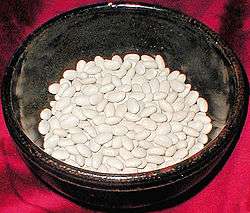Navy bean
 | |
| Nutritional value per 100 g (3.5 oz) | |
|---|---|
| Energy | 1,468 kJ (351 kcal) |
|
60.75 g | |
| Sugars | 3.88 g |
| Dietary fiber | 24.4 g |
|
1.5 g | |
|
22.33 g | |
| |
|
Percentages are roughly approximated using US recommendations for adults. Source: USDA Nutrient Database | |
The navy bean, haricot or pearl haricot bean, white pea bean,[1] or pea bean,[2] is a class of the common bean (Phaseolus vulgaris). It is a small, dry white bean which is smaller than many other types of white beans, and has an oval, slightly flattened shape. It features in such dishes as baked beans and even pies, as well as in various soups such as Senate bean soup.[3] Unlike canned vegetables, which lose much of their nutritive value in the canning process, navy beans maintain their nutritive value when canned.[4]
The plants that produce navy beans may be either of the bush type or vining type, depending on which cultivar they are.[5]
Consumption of baked beans has been shown to lower total cholesterol levels and low-density lipoprotein cholesterol.[6][7] This might be at least partly explained by high saponin content of navy bean. Saponins also exhibit antibacterial and anti-fungal activity, and have been found to inhibit cancer cell growth.[8] Furthermore, navy bean is the richest source of ferulic acid and p-coumaric acid among the common bean varieties.[9] It is commonly known as the "Navy Bean" due to its use as a staple of United States Navy rations in the 19th century.
Cultivars
Navy bean cultivars include:
- 'Rainy River'[10]
- 'Robust', resistant to the bean common mosaic virus (BCMV),[11] which is transmitted through seeds[10]
- Michelite, descended from 'Robust', but with higher yields and better seed quality[10]
- Sanilac, the first bush navy bean cultivar[10]
Other white beans
Other white beans include:
- cannellini, a variety popular in central and southern Italy, which is larger than navy beans, related to the kidney bean and, like the kidney bean, has higher levels of the toxic lectin phytohaemagglutinin.
- 'Great northern', also called "large white" beans are also larger than navy beans but smaller than cannellini beans, with a flattened shape similar to lima beans. They have a delicate flavour.
- The large white beans known in Greece as gígantes (Greek: γίγαντες, giants) and eléfantes (ελέφαντες, elephants) are from the runner bean, Phaseolus coccineus.
Nutritional value
White beans are the most abundant plant-based source of phosphatidylserine (PS) yet known.[12]
Storage and Safety
Dried and canned beans stay fresh longer by storing them in your pantry or other cool, dark place under 75 degrees Fahrenheit (24 °C). With normal seed storage, seeds should last from one to four years for replanting, with a very large time table for cooking for well kept seeds nearing on indefinite. Avoid beans which are discolored from the pure white of these beans, as they may have been poorly handled while they dried.[13]
References
- ↑ "Bean (Phaseolus vulgaris)". Pulse Canada. Retrieved 30 August 2014.
- ↑ "Pea bean". The American Heritage Dictionary. Retrieved 2013-09-17.
- ↑ senate.gov/reference/reference_item/bean_soup.htm Senate Bean Soup]
- ↑ http://www.tarladalal.com/glossary-haricot-beans-708i
- ↑ Mark Goodwin (2003). "Crop Profile for Dry Beans" (PDF). Pulse Canada. Retrieved 30 August 2014.
- ↑ Susan M. Shutler, Gemma M. Bircher, Jacki A. Tredger, Linda M. Morgan, Ann F. Whine Rand and A. G. LOW (1989). The effect of daily baked bean (Phaseolus vulgaris) consumption on the plasma lipid levels of young, normo-cholesterolaemic men. British Journal of Nutrition, 61, pp. 257–265 doi:10.1079/BJN19890114.
- ↑ Donna M. Winham, Andrea M. Hutchins. Baked bean consumption reduces serum cholesterol in hypercholesterolemic adults. Nutrition research (New York, N.Y.) 1 July 2007 (volume 27 issue 7 pp. 380–386 doi:10.1016/j.nutres.2007.04.017).
- ↑ John Shi, Sophia Jun Xue, Ying Mab, Dong Li, Yukio Kakuda, Yubin Lan. Kinetic study of saponins B stability in navy beans under different processing conditions. Journal of Food Engineering 93 (2009) 59–65.
- ↑ Devanand L. Luthria, Marcial A. Pastor-Corrales. Phenolic acids content of fifteen dry edible bean (Phaseolus vulgaris L.) varieties. Journal of Food Composition and Analysis 19 (2006) 205–211.
- 1 2 3 4 James D. Kelly. "One Hundred Years of Bean Breeding at Michigan State University: A Chronology" (PDF). Retrieved 30 August 2014.
- ↑ Schwartz, H.F.; Corrales, M.A.P. (1989). Bean Production Problems in the Tropics. Centro Internacional de Agricultura Tropical (CIAT). ISBN 9789589183045.
- ↑ Souci SW, Fachmann E, Kraut H (2008). Food Composition and Nutrition Tables. Medpharm Scientific Publishers Stuttgart.
- ↑ "How Long Do Beans Last?". Retrieved 23 November 2014.